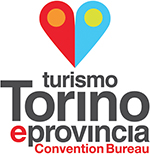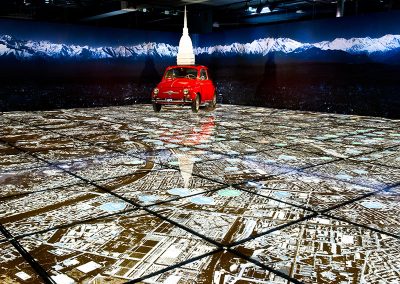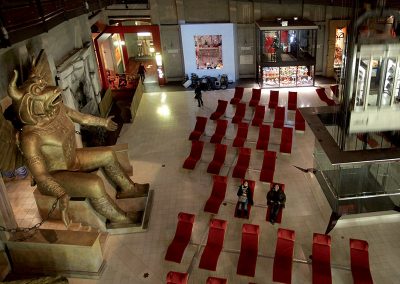
ABOUT TURIN
Torino is a city in constant evolution: from Augusta Taurinorum (after 27 a.C.) to the capital of the Savoy Dukedom (1563) until becoming Italy’s first capital (1861), the queen of the automobile industry (1899) and the star of the 2006 Winter Olympics. Today it is being presented with an image that makes it even more appealing. Torino is a city that is just waiting to be discovered in all of its many aspects: filled with historic evidence, acclaimed museums, works of contemporary art en plein air, cultural events, with its characteristic porticos, renowned historical meeting places, its extensive parks and magic places.

WHAT TO SEE
MUSEUMS
Museo Egizio (Egyptian Museum) – the world’s most prominent one after the museum in Cairo – to the National Museum of Cinema in the glorious setting of the Mole Antonelliana, from the Museum of Ancient Art at Palazzo Madama to the National Museum of the Italian Risorgimento in Palazzo Carignano. Torino’s industrial vocation has found its exhibition centre in the renovated MAUTO National Automobile Museum which tells of the city’s automotive history and the social issues related to it.
Torino is also a point of reference for contemporary art: works and installations produced by internationally famous artists are placed for all to see in the open air or on display at several museums and foundations such as GAM-Gallery of Modern and Contemporary Art, the Museum of Contemporary Art at Rivoli Castle, the Sandretto Re Rebaudengo Foundation, the Merz Foundation and the Giovanni e Marella Agnelli Art Gallery.
ROYAL RESIDENCES
Known as the “Crown of Delights”, the group of castles built by the House of Savoy and recognised as a World Heritage Site by UNESCO in 1997 looks like a large crown when seen from above, composed by Palazzo Reale, the Savoy Gallery, the Royal Armoury, the Royal Library and the Archaeological Museum, form the “Royal Hub”, Palazzo Madama and Palazzo Carignano.
Along the River Po is Valentino Castle, built by Christine of France in the French style and now housing the Faculty of Architecture of Torino Polytechnic. Just a short way from the centre, the hill embraces Villa della Regina, surrounded by Italianate gardens with pavilions, fountains and agricultural areas.
The incredible Royal Palace of Venaria now hosts major events, exhibitions and concerts in its magnificent interiors and spectacular gardens.
A favourite spot of the Savoy family for sumptuous feasts and solemn weddings was the Stupinigi Hunting Lodge, modeled on the style of contemporarily built Central European residences.
MAIN PLACES OF WORSHIP
Since 1578, the Duomo – the only example of Renaissance art in the city – has held the Holy Shroud, the Cloth claimed to have wrapped the body of Christ. Devotees can visit the corresponding Museum in the crypt of the Church of the Santissimo Sudario.
Not only are Torino’s churches places of worship, they are also fine examples of architecture and art, mainly in baroque style: the church of San Lorenzo, the first work commissioned of Guarino Guarini by the Court of Savoy, the twin churches of Santa Cristina and San Carlo in the Piazza of the same name, the impressive church of San Filippo by Juvarra and the Basilica della Consolata – much loved by Torino’s citizens – are well worth a visit not just by churchgoers. The new church of Santo Volto – by the architect Botta – is an admirable example of use of land reclaimed from former industrial areas.
TASTE TORINO
HISTORICAL CAFÉS
If then, in the middle of the day, strolling beneath the elegant colonnades of the centre, your eye is caught by the inviting windows of the historical cafés, give in to the temptation of the hot drinks like “bicerin” based on coffee, chocolate and cream, “zabaione” and hot chocolate, in the café rooms decorated with mirrors, wood panelling and satin upholstery, where the atmosphere of the Risorgimento period can be experienced.
CHOCOLATE
In Torino, in the 18th century, chocolate began to be processed and solidified, creating delicious products for satisfying the Court of Savoy and this led to the “invention” of gianduiotti, chocolates, pralines, cakes, biscuits, “pinguino” ice-creams and hot chocolate: world famous specialities which make Torino the Italian capital of traditional chocolate.
WHAT TO DO
SHOPPING
The area traditionally devoted to shopping is between Via Roma, heart and symbol of the city, and the pedestrian zones of Via Carlo Alberto and Via Lagrange where the shop windows of all the big names in fashion and jewellery glitteringly shine. Via Garibaldi is younger and trendier, Via Po is more “intellectual” with the bookshops and stores selling new and used records.
Torino has many markets. The top one is at Porta Palazzo, the town’s true multiethnic heart in terms both of people and of the goods on display. Nearby there is also Balôn, the historical flea-market.
NIGHTLIFE
Piazza Vittorio Veneto, on the River Po, Borgo Dora and the Roman Quarter – the city’s real centre – are home to many trendy spots: here art, food and design make the atmosphere even more sparkling, here you can listen to classical music, pop and jazz all strictly live, you can chat, watch artistic performances, dance until dawn. Also San Salvario has an irresistible allure, the multiethnic district (between Porta Nuova station and Valentino Park), the focus of a major urban renewal project.
However, if your idea of an evening is more… classic, and you experience a thrill every time the curtain rises, then be enchanted by opera, concerts, dance, great drama and the avant-garde that tread the boards of the many theatres in the city: discover the Regio Theatre, Auditorium del Lingotto, Auditorium RAI, and Carignano Theatre.
Thanks to








